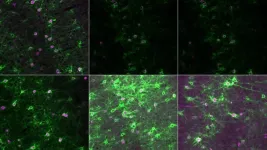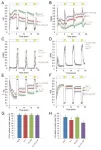(Press-News.org) Developing brains become shaped by the sights, sounds, and experiences of early life. The brain’s circuits grow more stable as we age. However, some experiences later in life open up opportunities for these circuits to be rapidly rewired. New research from Cold Spring Harbor Laboratory Associate Professor Stephen Shea helps explain how the brain adapts during a critical period of adulthood: the time when new mothers learn to care for their young.
Shea’s work in mice shows how this learning process is disrupted when a small set of neurons lack a protein called MECP2. In humans, MECP2 dysfunction causes the rare neurodevelopmental disorder Rett syndrome. Shea’s findings could point researchers toward the brain circuits involved in Rett syndrome and potential treatment strategies. His research could also have implications for more common neurological conditions. Shea explains:
“It’s not lost on us that Rett syndrome patients have difficulty interpreting and producing language. Difficulties with communicating are widespread in autism spectrum disorders. One of the reasons we study Rett syndrome is that this may be a valuable model for other forms of autism.”
The Shea lab’s studies of MECP2 began about 10 years ago when he first learned that female mice with mutations in the Mecp2 gene are poor parents. When it comes to parenting, most mother mice are quick learners. But without adequate MECP2 protein, Shea says, “they neglect their children and don’t listen to their cries.”
Shea and his team tested how eliminating MECP2 from specific cells in the mouse brain affected maternal behavior. They found that for pup retrieval to be delayed, the protein only had to go missing from a small subset of cells in a sound-processing part of the brain. The crucial cells are known as parvalbumin (PV) neurons. To efficiently learn to retrieve their pups, mice need MECP2 in those specific brain cells when they first hear the young animals’ cries of distress.
Shea points out that PV neurons also play an essential role in brain circuits earlier in life. These cells normally dampen the signals of other neurons. But they release this inhibition during development, creating conditions that are favorable for change. Shea says:
“We find that some of the same mechanisms engaged in development are actually at play in adults. They can be reactivated and repurposed for rewiring the brain in a new life time point.”
In other words, it’s not just about development or adulthood. This research may provide clues about brain disorders that arise later on, like dementia and Alzheimer’s disease.
END
Reactivate, repurpose, and rewire the brain
2023-10-04
ELSE PRESS RELEASES FROM THIS DATE:
American Society for Metabolic and Bariatric Surgery names new executive director after yearlong search
2023-10-04
After a yearlong and extensive nationwide search, the American Society for Metabolic and Bariatric Surgery (ASMBS), the nation’s largest professional organization of bariatric and metabolic surgeons and integrated health professionals, has named healthcare association veteran Diane M. Enos MPH, RDN, CAE, FAND, to serve as its new executive director.
Before joining ASMBS, Enos, a registered dietitian and certified association executive with a master’s degree in public health from the University of Texas Health Science Center in Houston, was Chief Learning Officer of the Academy of Nutrition and Dietetics, ...
Antibody therapy inspired by patient case reduced tau tangles in a preclinical model of Alzheimer’s disease
2023-10-04
A team led by researchers from Mass General Brigham reports promising results for a monoclonal antibody that takes aim at a new target for Alzheimer’s disease. Inspired by their previous identification of a genetic variant in the APOE gene that provides extreme resistance against Alzheimer’s disease, the team, which includes investigators from Mass Eye and Ear and Massachusetts General Hospital, developed a therapy that mimics the behavior of this genetic variant in a preclinical model, reducing ...
Demystifying the role of plant x- and y-type thioredoxins
2023-10-04
The potential for exposure to fluctuating light has necessitated that plants evolve protective mechanisms for when the light intensity exceeds photosynthetic capacity. Under these conditions, reactive oxygen species cause photoinhibition, which hinders photosynthetic efficiency. To counter this loss in photosynthetic efficiency, chloroplasts evolved thioredoxin (Trx) proteins that regulate redox balance within the photosynthetic apparatus and provide a photoprotective function. These proteins allow plants to modulate photosynthesis in response to variations in light intensity. ...
Graphene oxide reduces the toxicity of Alzheimer’s proteins
2023-10-04
A probable early driver of Alzheimer's disease is the accumulation of molecules called amyloid peptides. These cause cell death, and are commonly found in the brains of Alzheimer’s patients. Researchers at Chalmers University of Technology, Sweden, have now shown that yeast cells that accumulate these misfolded amyloid peptides can recover after being treated with graphene oxide nanoflakes.
Alzheimer’s disease is an incurable brain disease, leading to dementia and death, that causes suffering for both the patients and their ...
Avatars to help tailor glioblastoma therapies
2023-10-04
Scientists have created a new zebrafish xenograft platform to screen for novel treatments for an aggressive brain tumor called glioblastoma, according to a new study by the Gerhardt and De Smet labs published in EMBO Molecular Medicine.
Joint press release – Max Delbrück Center, VIB, and KU Leuven
Glioblastoma is an aggressive and difficult-to-treat brain tumor in adults. On average, patients survive for only 1.5 years. The standard of care treatment for this disease, which includes surgery followed by radiation and chemotherapy, has not changed in 18 years. That’s partly because the cancer is ...
Oxford researchers develop 3D printing method that shows promise for repairing brain injuries
2023-10-04
Researchers have produced an engineered tissue representing a simplified cerebral cortex by 3D printing human stem cells.
When implanted into mouse brain slices, the structures became integrated with the host tissue.
The technique may ultimately be developed into tailored repairs to treat brain injuries.
A breakthrough technique developed by University of Oxford researchers could one day provide tailored repairs for those who suffer brain injuries. The researchers demonstrated for the first time that neural cells can be 3D printed to mimic the architecture of the cerebral cortex. The results have been published today in the ...
Tracking the bacteria behind life-threatening sepsis in premature babies
2023-10-04
Premature babies in neonatal care units are extremely vulnerable, and susceptible to life-threatening infections. To help keep these babies safe the risk of infection needs to be kept as low as possible.
A particular problem is late onset sepsis that starts from three days after birth, when bacteria get into the blood and grow. This can be very dangerous and babies with late onset sepsis end up staying in hospital longer, need more treatment with antibiotics and can be left with life-long effects on their health.
Bacteria from the Staphylococcus family are the most common causes ...
Intervention for caregivers helps prevent elder mistreatment
2023-10-04
An educational and social support intervention for caregivers reduced elder mistreatment of older adults with chronic illness, including dementia. That’s the result of a recent double-blind, randomized controlled trial published in the Journal of the American Geriatrics Society.
Elder mistreatment is defined as “an intentional act or failure to act by a caregiver or another person in a relationship involving an expectation of trust that causes or creates a risk of harm to an older adult.” Through the Comprehensive Older Adult and Caregiver Help (COACH) intervention tested in this trial, coaches met with caregivers weekly for up to 12 sessions to listen to their ...
Does COVID-19 or COVID-19 vaccination worsen migraines?
2023-10-04
Research published in the European Journal of Neurology indicates that COVID-19 and COVID-19 vaccination have negligible effects on migraine severity.
Among 550 adults who had received migraine-related care at a Spanish headache clinic, 44.9% (247) reported COVID-19 at least once and 83.3% (458) had been vaccinated; 61 patients (24.7%) reported migraine worsening since COVID-19 and 52 (11.4%) since vaccination.
In participants who perceived that their migraines worsened, those who had been infected were 2.5-times more ...
Are opioid prescription rates changing for US adolescents?
2023-10-04
A new analysis reveals that rates of opioid prescribing to US adolescents have decreased in recent years, primarily limited to non-surgery indications. Opioid prescription rates for surgery have remained stable.
The analysis, which is published in Pediatric Anesthesia, assessed data from the 2015–2020 Medical Expenditure Panel Surveys, which are nationally representative, large-scale surveys conducted annually by the Agency for Healthcare Research and Quality.
Among 26,909 children aged 10–19 years, 4.7% underwent a surgical procedure in 2015–2020. ...






